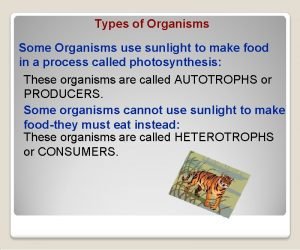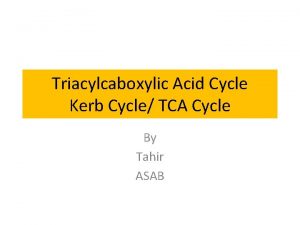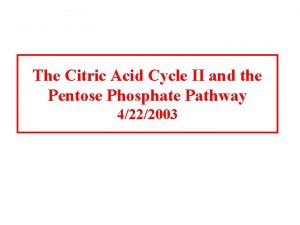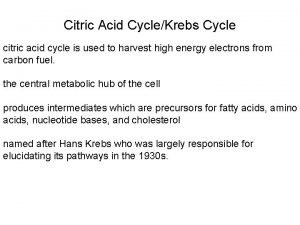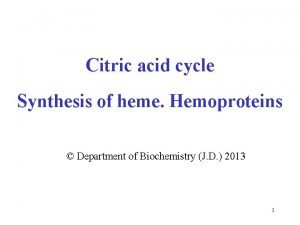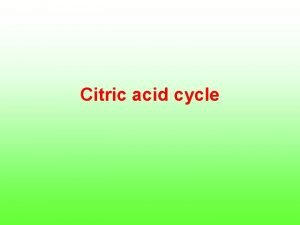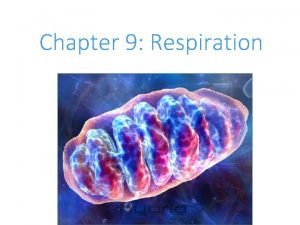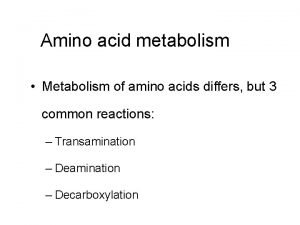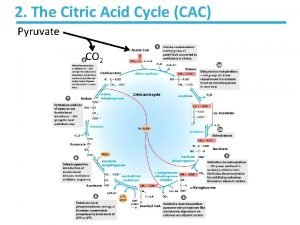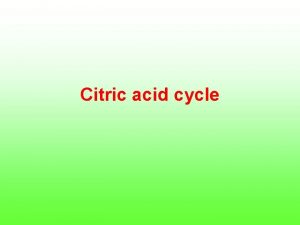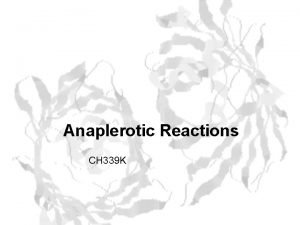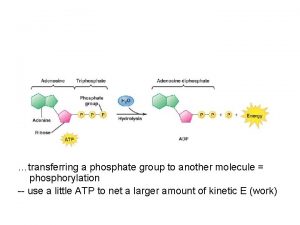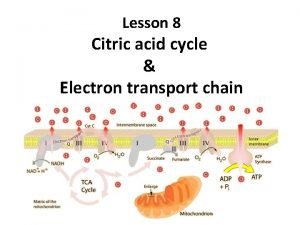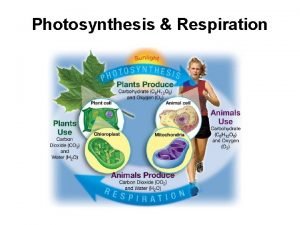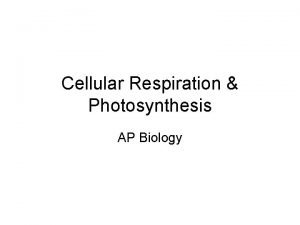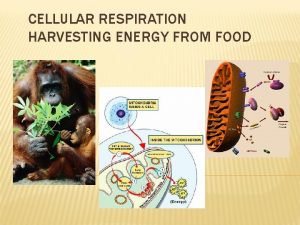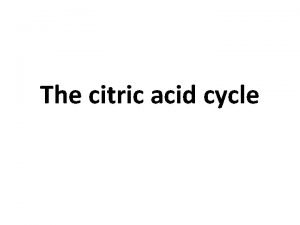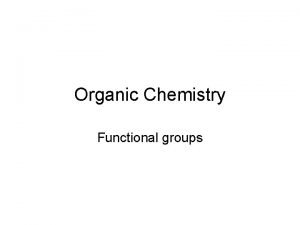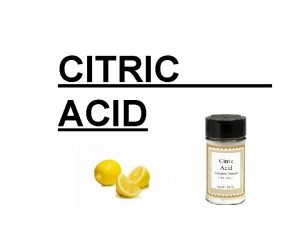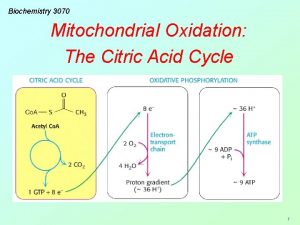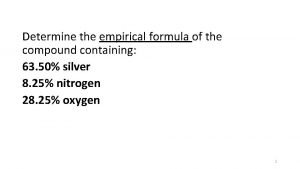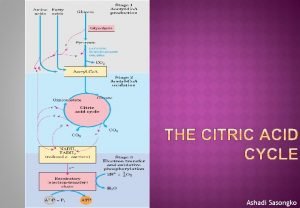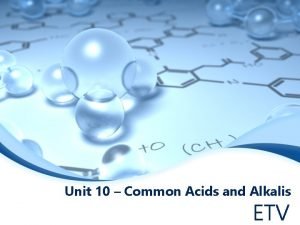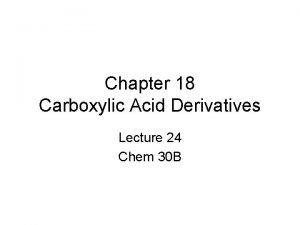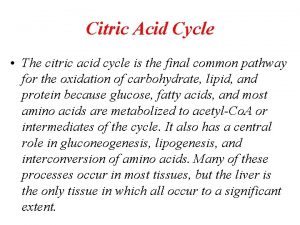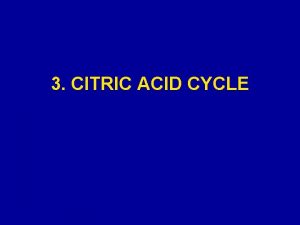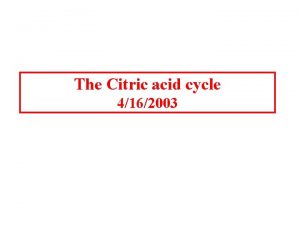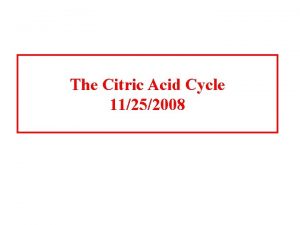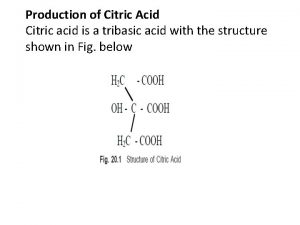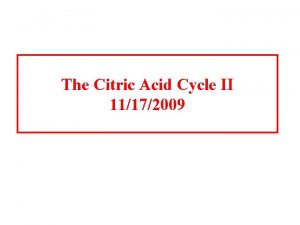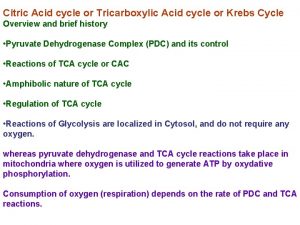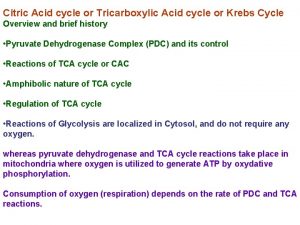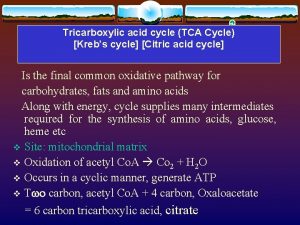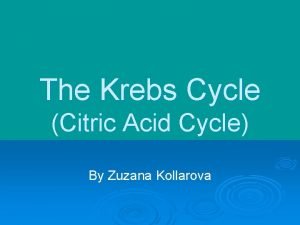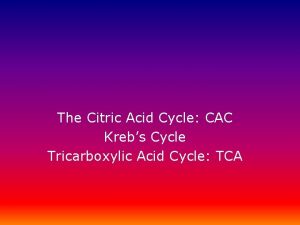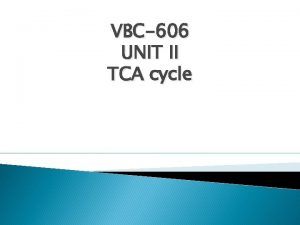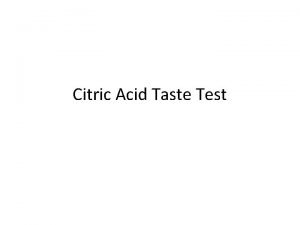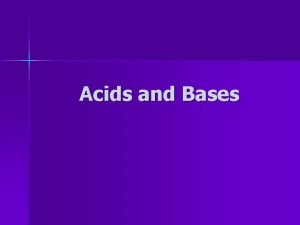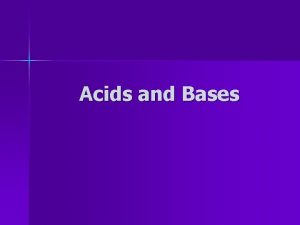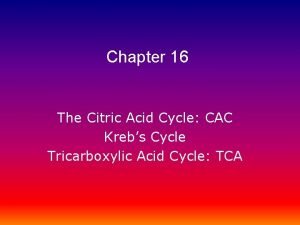The Citric Acid Cycle The citric acid cycle






























- Slides: 30

The Citric Acid Cycle The citric acid cycle is the final common pathway for the oxidation of fuel molecules: amino acids, fatty acids, & carbohydrates. • Most fuel molecules enter the cycle as acetyl coenzyme A • This cycle is the central metabolic hub of the cell • It is the gateway to aerobic metabolism for any molecule that can be transformed into an acetyl group or dicarboxylic acid, • It is also an important source of precursors for building blocks • Also known as, Krebs Cycle, & Tricarboxylic Acid Cycle (TCA) Chapter 17: Outline 17. 1 The citric acid cycle oxidizes two-carbon units 17. 2 Entry to the cycle and metabolism through it are controlled 17. 3 The cycle is a source of biosynthetic precursors

Overview of citric acid cycle 1. The function of the cycle is the harvesting of high-energy electrons from carbon fuels • The cycle itself neither generates ATP nor includes O 2 as a reactant • Instead, it removes electrons from acetyl Co. A & uses them to form NADH & FADH 2 (high-energy electron carriers) • In oxidative phosphorylation, electrons from reoxidation of NADH & FADH 2 flow through a series of membrane proteins (electron transport chain) to generate a proton gradient • These protons then flow back through ATP synthase to generate ATP from ADP & inorganic phosphate • O 2 is the final electron acceptor at the end of the electron transport chain • The cytric acid cycle + oxidative phosphorylation provide > 95% of energy used in human aerobic cells

Fuel for the Citric Acid Cycle Initiates cycle Pantothenate Thioester bond to acetate -mercapto-ethylamine

Mitochondrion Double membrane, & cristae: invaginations of inner membrane

Mitochondrion Oxidative decarboxilation of pyruvate, & citric acid cycle take place in matrix, along with fatty acid oxidation Site of oxidative phosphorylation Permeable

Citric Acid Cycle: Overview Input: 2 -carbon units Output: 2 CO 2, 1 GTP, & 8 high-energy electrons

Cellular Respiration 8 high-energy electrons from carbon fuels Electrons reduce O 2 to generate a proton gradient ATP synthesized from proton gradient

Glycolysis to citric acid cycle link Acetyl Co. A link is the fuel for the citric acid cycle

Pyurvate dehydrogenase complex A large, highly integrated complex of three kinds of enzymes Pyruvate + Co. A + NAD+ acetyl Co. A + CO 2 + NADH Groups travel from one active site to another, connected by tethers to the core of the structure

Coenzymes B 1 vitamin

TPP Vitamin B 1

Citrate Cycle: step 1 (citrate formation) Enzyme: Citrate synthase Condensation reaction Hydrolysis reaction

Conformational changes in citrate synthase Homodimer with large (blue) & small (yellow) domains Open form Closed form

Citrate isomerized to Isocitate: step 2 Enzyme: aconitase Dehydration Hydration

Aconitase: citrate binding to iron-sulfur cluster 4 Fe-4 S iron-sulfur cluster

Isocitrate to -ketoglutarate: step 3 Enzyme: isocitrate dehydrogenase 1 st NADH produced 1 st CO 2 removed

Succinyl Co. A formation: step 4 Enzyme: -ketoglutarate dehydrogenase 2 nd NADH produced 2 nd CO 2 removed

Succinate formation: step 5 Enzyme: succinyl Co. A synthetase GTP produced GTP + ADP GDP + ATP (NPTase)

Succinyl Co. A synthetase Rossman fold binds ADP component of Co. A ATP-grasp domain is a nucleotide-activating domain, shown binding ADP. His residue picks up phosphoryl group from near Co. A, & swings over to transfer it to the nucleotide bound in the ATP-grasp domain

Oxaloacetate regenared by oxidation of succinate: Steps 6 - 8 Oxidation, hydration, and oxidation

Succinate to Fumarate: step 6 Enzyme: succinate dehydrogenase FADH 2 produced

Fumarate to Malate: step 7 Enzyme: fumarase

Fumurate to L-Malate Hydroxyl group to one side only of fumarate double bond; hence, only L isomer of malate formed

Malate to Oxalate: step 8 Enzyme: malate dehydrogenase 3 rd NADH produced

The citric acid cycle

Summary of 8 steps Proton gradient generates 2. 5 ATP per NADH, & 1. 5 per FADH 2 9 ATP from 3 NADH + 1 FADH 2. Also, 1 GTP Thus, 1 acetate unit generates equivalent of 10 ATP molecules. In contrast, 2 ATP per glucose molecule in anaerobic glycolysis

Pyruvate to Acetyl Co. A, irreversible Key irreversible step in the metabolism of glucose

Regulation of pyruvate dehydrogenase Inhibited by products, NADH & Acetyl Co. A Also regulated by covalent modification, the kinase & phosphatase also regulated

Control of citric acid cycle Regulated primarily by ATP & NADH concentrations, control points: isocitrate dehydrogenase & - ketoglutarate dehydrogenase (citrate synthase - in bacteria)

Biosynthetic roles of the citric acid cycle
 Krebs cycle main purpose
Krebs cycle main purpose How is citric acid cycle regulated
How is citric acid cycle regulated Citric acid cycle overall reaction
Citric acid cycle overall reaction Inputs of krebs cycle
Inputs of krebs cycle Citric acid cycle net equation
Citric acid cycle net equation Citric acid cycle definition
Citric acid cycle definition Where does the citric acid cycle occur
Where does the citric acid cycle occur Deamination of amino acids
Deamination of amino acids Oxaloacetate
Oxaloacetate Citric acid cycle overall reaction
Citric acid cycle overall reaction Citric acid cycle definition
Citric acid cycle definition Citric acid cycle
Citric acid cycle Citric acid cycle
Citric acid cycle 4 carbon compound in krebs cycle
4 carbon compound in krebs cycle Cellular respiration
Cellular respiration Photosynthesis citric acid cycle
Photosynthesis citric acid cycle Citric acid cycle and electron transport chain
Citric acid cycle and electron transport chain Photosynthesis citric acid cycle
Photosynthesis citric acid cycle Oxidation of citric acid
Oxidation of citric acid Chemistry
Chemistry Citric acid purification
Citric acid purification Oxidation of citric acid
Oxidation of citric acid Greenhouse lab
Greenhouse lab Empirical formula of citric acid
Empirical formula of citric acid Citric acid
Citric acid Citric acid in water
Citric acid in water Physical property and chemical property
Physical property and chemical property 9-which acid is not considered a strong acid?
9-which acid is not considered a strong acid? Differentiate between acid fast and non acid fast bacteria
Differentiate between acid fast and non acid fast bacteria Anhydride leaving group
Anhydride leaving group Acid fast and non acid fast bacteria
Acid fast and non acid fast bacteria
